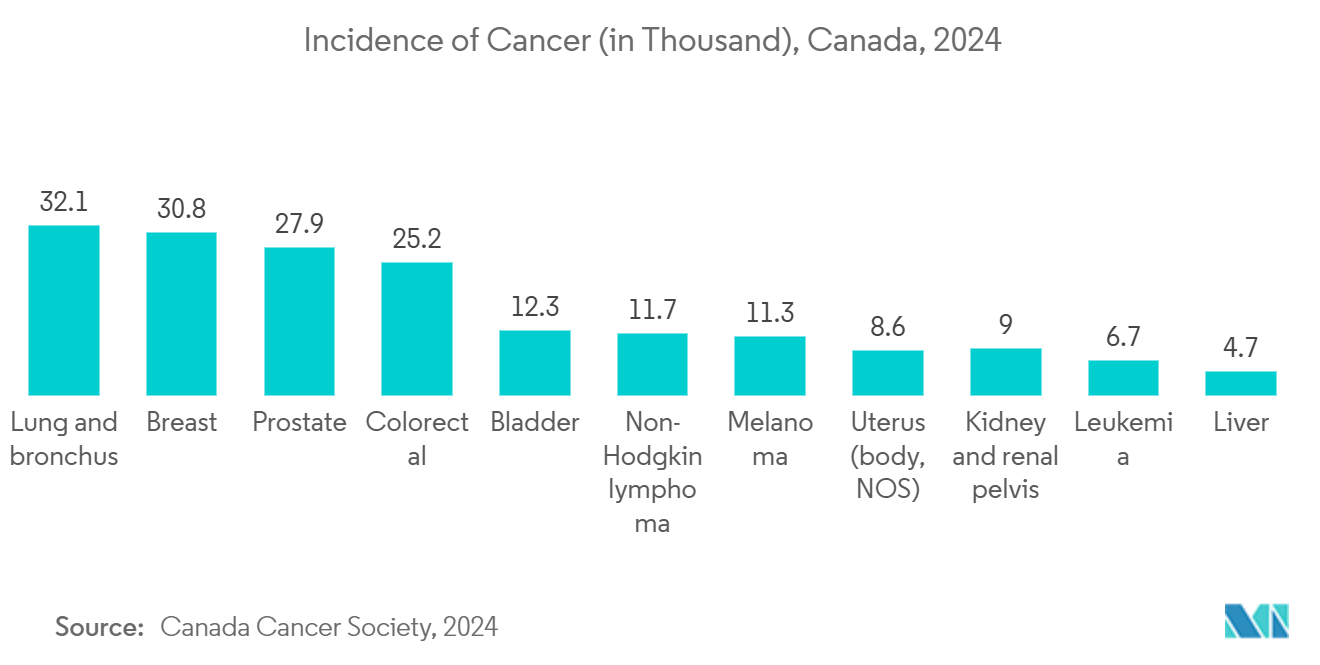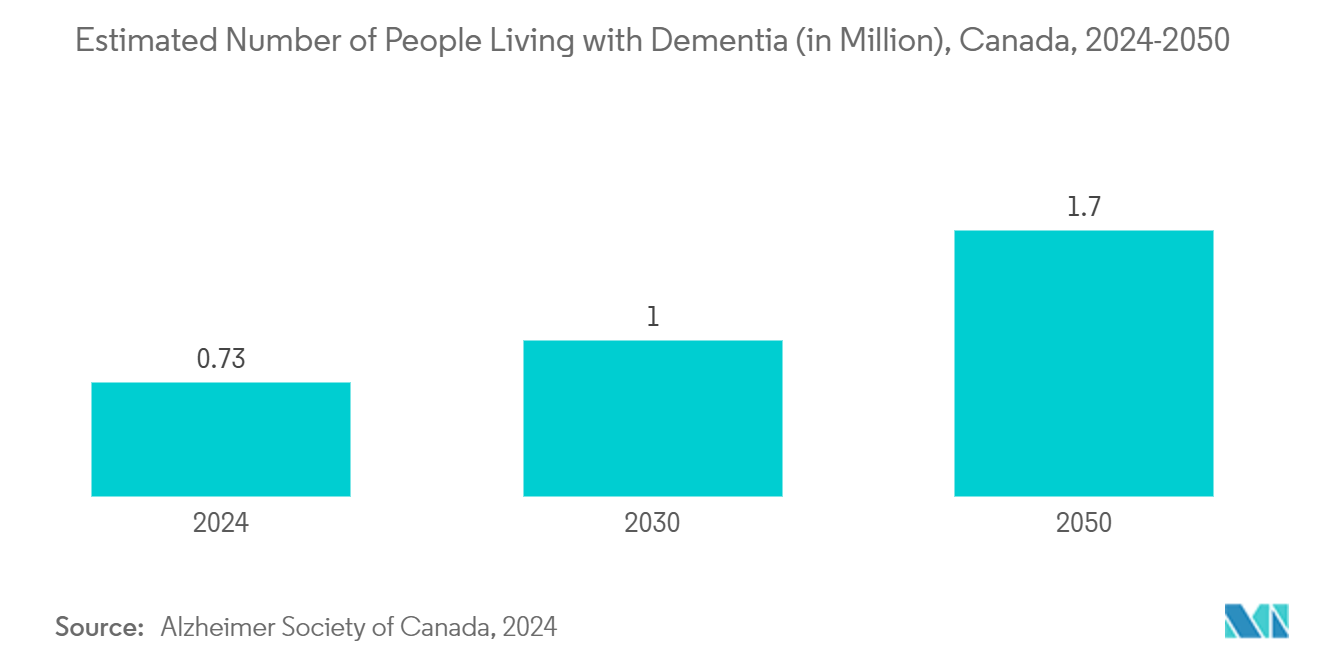Market Trends of Canada Nuclear Imaging Industry
Oncology Segment is Expected to Witness Considerable Growth Over the Forecast Period
Oncology refers to the study, treatment, diagnosis, and prevention of cancer. In recent times, nuclear imaging has been majorly used in the diagnosis and treatment of cancer. The advantage of nuclear medicine therapy for cancer is that the use of radioactive molecules specifically recognizes the tumor cells. The molecules are injected intravenously. They circulate in the body, stick to the tumor cells, deliver radiation directly, and cause them to die. The wide use of nuclear medicine isotopes in cancer therapy is expected to add to the growth of the market over the forecast period.
The segment is driven by the increasing burden of cancer, the use of nuclear medicine in the diagnosis and treatment of cancer, ongoing research and development activities, and key strategic activities adopted by the market players, such as launches and collaboration.
The high burden of cancer diseases in the country is likely to increase demand for effective diagnosis and treatment with nuclear imaging, thereby boosting the market growth. For instance, as per the Canadian Cancer Statistics 2023 report, about 239.2 thousand new cancer cases were reported in 2023 in Canada, compared to 233.9 thousand in 2022. Such high cancer cases are increasing the demand for advanced diagnostic tools like PET scans in nuclear medicine, which help provide valuable insights into the presence, location, and metabolic activity of tumors, thereby driving the growth of the studied market in the country.
Moreover, strategic activities such as the launch of nuclear medicine used in oncology, mergers, acquisitions, and partnerships by market players are expected to contribute to segment growth over the forecast period. For instance, in February 2023, Canadian Nuclear Laboratories (CNL) has teamed up with Jubilant Radiopharma to pioneer new alpha radiopharmaceuticals. This collaboration, part of CNL's Canadian Nuclear Research Initiative, Health (CNRI-H) program, focuses on discovering and developing innovative radiopharmaceutical therapies. These include targeted alpha therapy and advanced cancer treatments utilizing Actinium-225, a medical isotope produced by CNL.
Given Canada's significant cancer burden and the industry's proactive initiatives is anticipating robust market growth during the forecast period.

SPECT Radioisotopes Segment is Expected to Witness Significant Growth Over the Forecast Period
Single-photon emission computed tomography (SPECT) scan serves as an imaging test, illustrating blood flow to various tissues and organs. It's instrumental in diagnosing conditions such as seizures, strokes, stress fractures, infections, and spinal tumors. Commonly employed radioisotopes in SPECT for tracer labeling include iodine-123, technetium-99m, xenon-133, thallium-201, and fluorine-18. These radioactive isotopes, derived from natural elements, traverse the body and are detectable by the scanner. Additionally, a range of drugs and chemicals can be tagged with these isotopes.
Single photon emission computerized tomography (SPECT) stands as the predominant scanning technology for diagnosing and monitoring a range of medical conditions. The nuclear medicine radioisotopes market is witnessing growth, primarily driven by the expanding applications of SPECT and heightened patient awareness regarding radiation and its therapeutic uses.
The increasing number of cases of various diseases in Canada requiring SPECT imaging is one of the major drivers for the segment. For instance, as per Parkinson's Society Southwest Ontario 2024, by 2031, the population of Canadians over 40 diagnosed with Parkinson's disease is projected to rise by 65%, escalating from 99,000 in 2016 to an estimated 163,700. Specifically, for Canadians aged 65 and above, the count of those living with Parkinson's is set to more than double, reaching 148,800 by 2031. Single-photon emission computed tomography (SPECT) is a functional brain imaging procedure that allows physicians to measure functional changes in gray matter structures based on regional cerebral blood flow (rCBF). In addition, it can also be used as a diagnostic tool and a potential biomarker for monitoring and evaluating new treatments in patients with complex neuropsychiatric conditions.
Moreover, strategic activities such as the launch of SPECT products, mergers, and acquisitions, and partnerships by the market players to expand the market share are expected to contribute to segment growth over the forecast period. For instance, in June 2024, Nova Scotia Health’s QEII Health Sciences Centre became the first health center in Canada to obtain GE HealthCare's StarGuide SPECT/CT scanner. This cutting-edge nuclear medicine scanner employs 3D imaging, enabling physicians to diagnose and treat diseases, such as cancer and heart conditions, with heightened precision. With this advanced technology at their disposal, physicians are better equipped to make accurate diagnoses and offer informed treatment options to their patients.
Thus, the high burden of chronic diseases, significant application in SPECT imaging technological advancement, and product launch by the market players are anticipated to boost the market growth.


